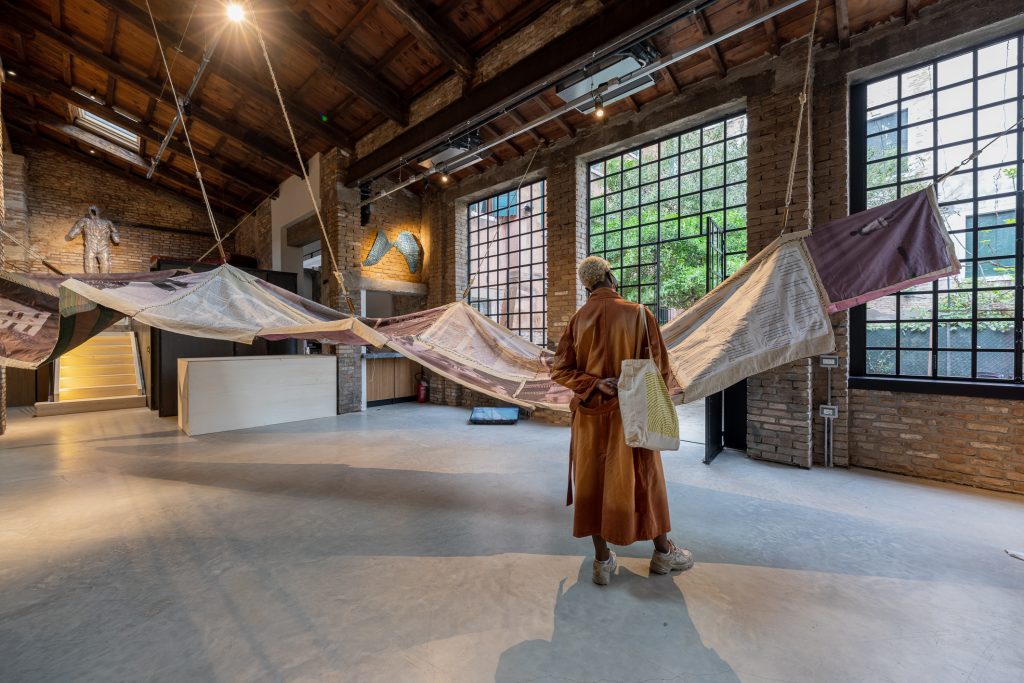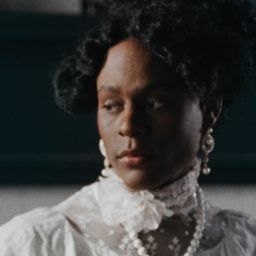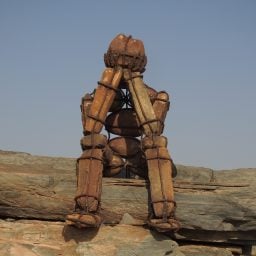One week before the 59th Venice Biennale was due to open this spring, Jimmy Ogonga, the curator of the Kenya Pavilion, still hadn’t received funding from Kenya’s ministry of culture.
It was the second time Ogonga had staged a pavilion for his home country, taking over after two scandalous editions in 2013 and 2015 in which Kenyan artists were all but left out. Ogonga was determined to correct the record and present an exhibition showcasing work by Kenyan artists that spoke directly to the socio-cultural and political issues they face.
“It is the Olympics of the art world,” Ogonga told Artnet News. “A country like ours plays a big role in the Olympics. We have some of the most amazing runners in the world. When we go to Venice, we don’t need to break records or win the Golden Lion, but we need to be there so we can be present with the rest.”
Though African countries have been increasingly visible in Venice in recent years, several national pavilions have been beset by lack of funding and local criticism of curatorial choices.
Over the past decade, prices for modern and contemporary art from the African continent have skyrocketed, making the category one of the fastest growing in the market. One could say there has been an African art Renaissance of sorts—but why has this not been felt with the same force at the Venice Biennale?
“So far, Africa’s representation on a national level in Venice has been a mess,” Cameroonian curator Simon Njami told Artnet News. “The nations have not understood that art can be a soft and efficient political tool.”
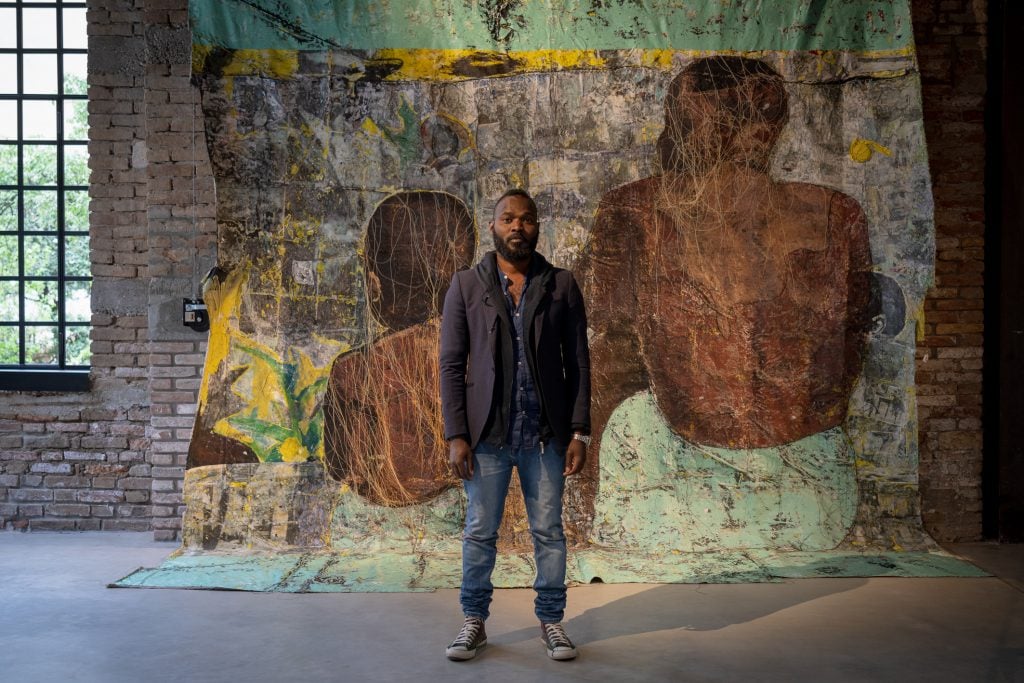
Artist Kaloki Nyama with his work at the Kenyan Pavilion,, “Exercises in Conversation,” at the 59th International Art Exhibition – La Biennale di Venezia. Photo: Andrea Avezzù. Courtesy: La Biennale di Venezia.
The Case of Kenya
Ogonga said this year’s pavilion, which included artists Dickens Otieno, Wanja Kimani, Syowia Kyambi, and Kaloki Nyamai, has been the nation’s most successful to date. “The Kenyan art scene has worked with its government in a mutual and non-combative way,” he said.
During Kenya’s debut in 2013 and then in 2015, a couple of Italian curators presented exhibitions dominated by Chinese and Italian artists. After its second showing in 2015, several prominent Kenyan artists protested, demanding that the government provide them proper representation in Venice. It worked—and the exhibition was publicly disowned by the Kenyan government. In 2016, Ogonga was appointed to set in place a roadmap for how to present Kenya and its artists in Venice.
“There was a complete lack of synchronicity between what was shown in Venice and what the art scene in Nairobi was trying to do,” Ogonga said. He added that the history of the art scene in Kenya has been riddled with problems, including how its artists are treated and represented internationally. Part of the issue stems from a lack of art infrastructure, an issue shared by many other nations around the globe: Kenya has no national arts council, no national gallery, and poorly funded art schools.
This is what often leads to foreign players taking over national pavilions on their behalf, Ogonga said. He noted that while outside proposals may sound legitimate at first, they have, in some instances, turned out to be “self-serving” initiatives.
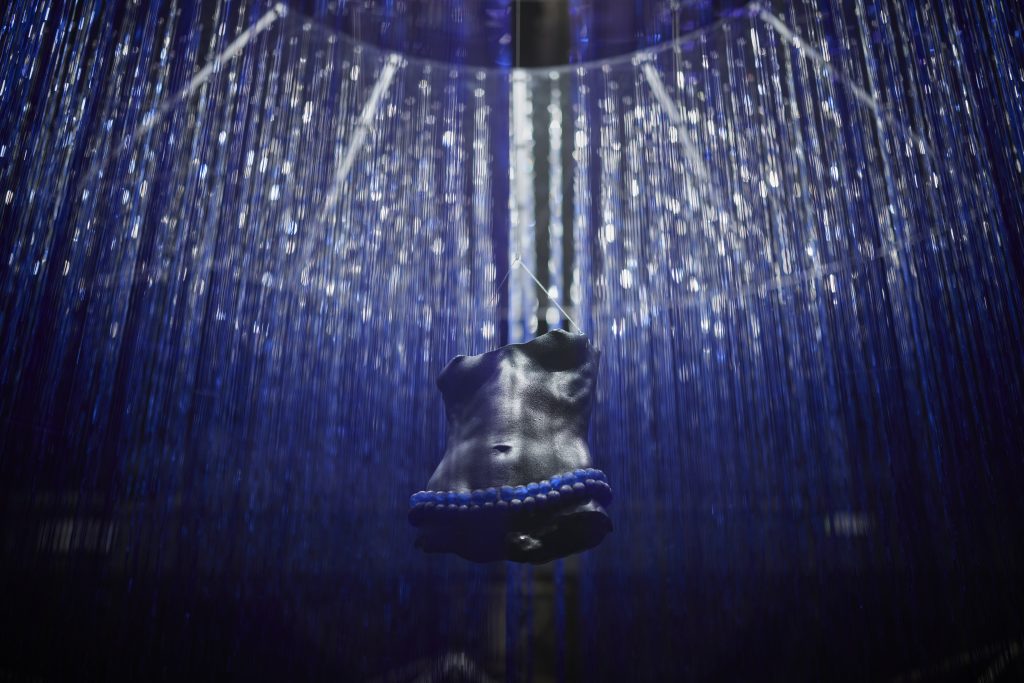
Ghana Pavilion, Arsenale, Venice Biennale 2022. Photo: David Levene.
Beset by Challenges
All told, this year, only nine African nations—Zimbabwe, Ivory Coast, Ghana, Kenya, Cameroon, South Africa, Namibia, Uganda, and Egypt—were present at the Venice Biennale. While the number is certainly an increase from previous years, it is by no means representative of the breadth and diversity of 54 countries’ artistic cultures.
It is even less representative when the art of those few African nations present has been metaphorically hijacked by foreigners using national pavilions in Venice for their own gain, as some nations, like Kenya, have claimed.
A related discussion surrounded Namibia’s inaugural pavilion this year. Italian Marco Furio Ferrario curated his first-ever art show with the work of a white Namibian man born in Johannesburg, South Africa; the selection prompted outrage from the Namibian and international art communities.
Cameroon, which also made its debut this year in Venice, saw its pavilion co-curated by Sandro Orlandi Stagl, who was behind Kenya’s embattled 2015 presentation. The project has two locations: one, an NFT exhibition organized by Global Crypto Art DAO, features the work of 20 artists—not one is Cameroonian. The second presents work by four Cameroonian artists and four international artists.
Meanwhile, Ghana, which made a splash at its debut in 2019, had no government funding this year, meaning that its curator, Nana Oforiatta-Ayim, had to procure the funds herself.
Challenges persisted when this year’s Egyptian pavilion curiously remained closed during the Biennale’s opening days. It presented an installation of giant pink balloons and digital works called “an artificial intelligence media installation” by Egyptian artists Mohamed Shoukry, Weaam El Masry, and Ahmed El Shaer. A prominent member of the Egyptian art scene said the closure was due to “technical difficulties,” but Egyptian artist Moataz Nasr, who represented Egypt at Venice Biennale in 2017, told Artnet News that when he showed five years ago, the ministry had not allocated a budget to pay docents to man the pavilion.
“I think Egypt should stop participating in the Biennale for a while until we renew the interior of the art scene inside the country,” Nasr told Artnet News.
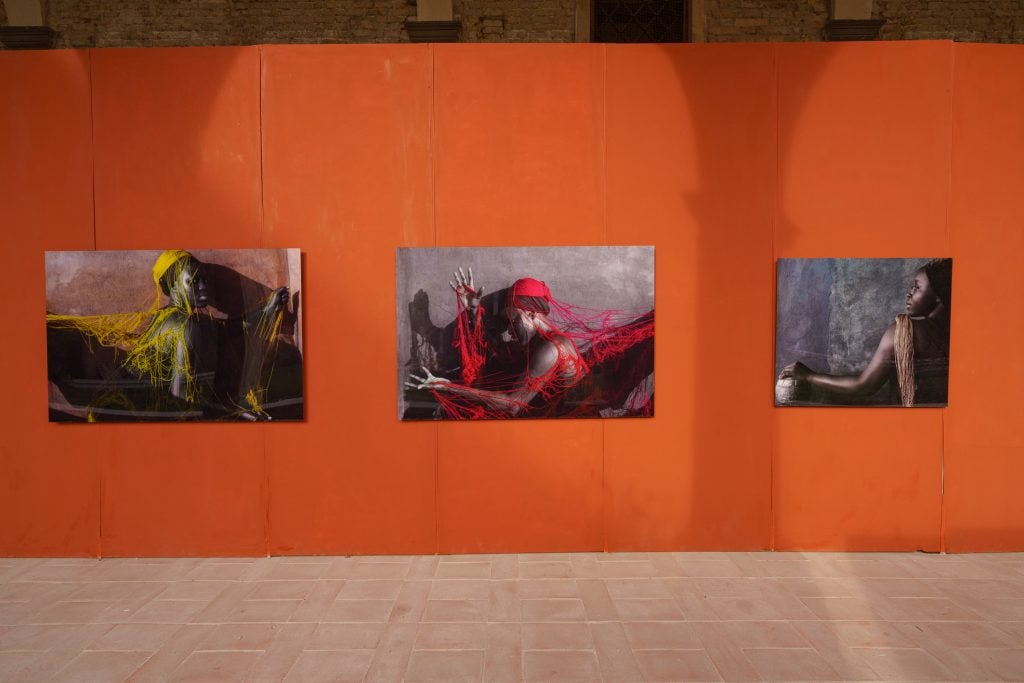
Angéle Etoundi Essamba at the Pavilion of Cameroon “Il tempo delle Chimere/The Time of the Chimeras.” Photo: Andrea Avezzù. Courtesy: La Biennale di Venezia.
Returns on Investment
While some could criticize the Biennale itself for not having a more thorough screening process, African ministries of culture also have a role to play in ensuring their country is properly represented (they must, after all, ratify their own national pavilions). Most states do not invest enough in art and when nations refuse to get involved, the private sector takes over.
“The investment needed to stage a national pavilion is huge and many of these countries need to invest first and foremost in public art engagement and support at home,” Hannah O’Leary, head of modern and contemporary African art at Sotheby’s, told Artnet News. She noted that the art market must be included in these considerations. “Very few artists from Africa are represented by blue-chip galleries who can provide them major financial and marketing support to participate in the Venice Biennale, safe in the knowledge that significant sales will follow at Art Basel and beyond.”
O’Leary further noted that, while we are seeing a marked improvement in the market for art from Africa over the past decade, “the fact remains that the vast majority of artists and galleries based in Africa sell at price points that do not justify that sort of investment.”
African curators like Simon Njami believe the solution lies in nations believing in the power and need for a national art program. “As long as African nations don’t have a consciousness of the importance of the Venice Biennale, then Africa won’t be well represented,” he said, adding that it costs around $300,000 to $500,000 to participate. “What does that represent in the national budget of a state, even the poorest? Peanuts. We need to build the infrastructure and the dialogue at home.”
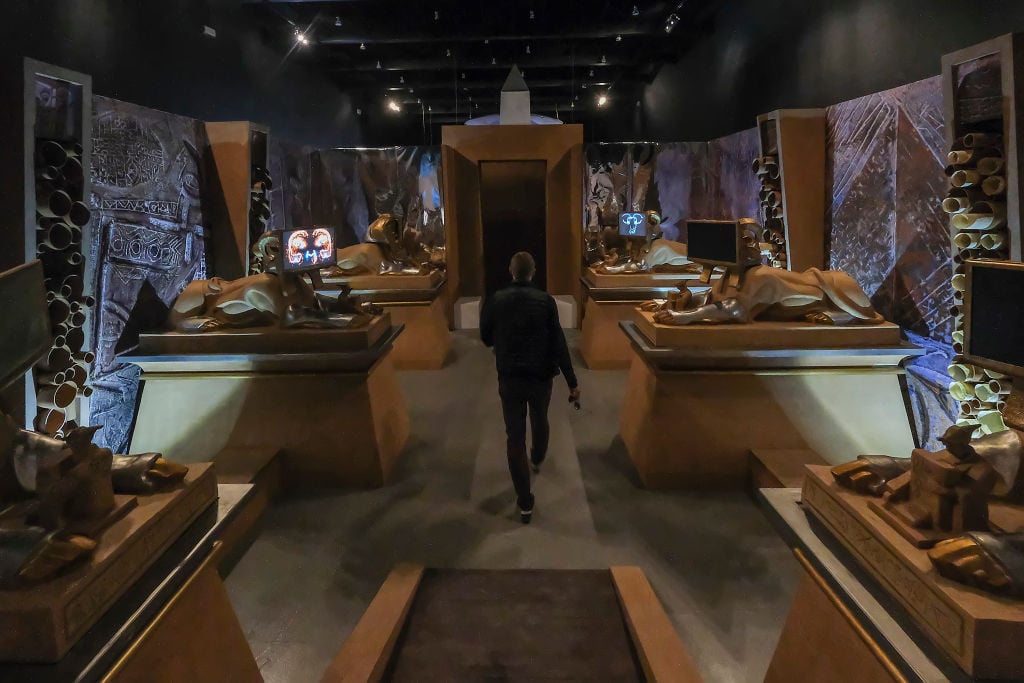
The Egypt pavilion, represented by the artists Islam Abdullah, Ahmed Chiha, Ahmed Abdel Karim, during press previews for the 58th International Art Biennale on May 08, 2019 in Venice, Italy. Photo: Stefano Mazzola/Awakening/Getty Images.
A Brief History of Africa in Venice
The issues that have come up in recent years are not new. Though Africa has actually been present at the Biennale since the 1920s, the show has never reflected the full diversity and strength of the continent’s cultural production—especially in the years before and just after decolonization began. An exception was Egypt, which in 1952 established the first permanent—and to this day, only—African pavilion in the Giardini. South Africa debuted at the Venice Biennale in 1950, participating during the following two decades until anti-apartheid protests led to its exclusion.
During the 1960s and ’70s, the issue of independence was often the main preoccupation of African countries and their artists, so it is not entirely surprising that they rarely appeared in international art events until the 1980s. Over the years, Africa’s lack of national pavilions was partially made up for by collateral projects: In 1999, the creation of the African Art in Venice Forum led to the implementation of an exhibition program devoted to contemporary African art.
In 2007, Robert Storr, curator of that year’s biennale, proposed that an African pavilion be created. His idea sparked outrage—how could an entire continent be represented by a single pavilion? The late Congolese collector Sindika Dokolo took up the idea and funded the project, yet the pavilion remained controversial as it largely presented his personal holdings.
Some years later, a big win came when, in 2013, Angola’s debut participation garnered it the prestigious Golden Lion Award for best national pavilion. Other participating African nations across Venice—which at the time included South Africa, Zimbabwe, Ivory Coast and Kenya—celebrated in unison.

Installation view, “Radiance – They Dream in Time,” 2022 Uganda Pavilion. Photo: Francesco Allegretto
The Victories
This year’s biennale marked successes for Africa, too. Uganda’s debut, a sleekly curated show by Shaheen Merali, featured Ugandan multidisciplinary performance and installation artist Acaye Kerunen and painter Collin Sekajugo. It was awarded a special mention for the Golden Lion.
“The Milk of Dreams,” the Venice Biennale’s central exhibition, also offered a strong showing of artists from the continent. Of the 213 artists from 58 countries invited by Cecilia Alemani, 12 represent the African continent. Notable were the dreamy large-than-life paintings of Zimbabwean Portia Zvavahera, which pair her emotional life with the spiritualism of indigenous Zimbabwean and Apostolic Pentecostalist beliefs of her upbringing. Ethiopian Elias Sime presented vibrant abstractions made from fragments of computer wire and electrical debris.
“It has been very important throughout the process of organizing this exhibition to meet artists and cultural practitioners from the African continent,” Alemani, who did much of her research and studio visits remotely, told Artnet News. She worked with three advisors from Africa—Nontobeko Ntombela, Kwasi Ohene-Ayeh, and Marie Hélène Pereira—who helped research and recommend artists. Alemani said she was particularly pleased to showcase work by three emerging talents from Southern Africa—Igshaan Adams and Bronwyn Katz from South Africa and Zvavahera from Zimbabwe.
Some, however, believe Biennale organizers and curators in general need to invest more in discovering global art scenes, including that of Africa, to bring more balanced representation to these international events.
“In this edition in particular, it is more than manifest that virtually every African artist included had been exhibited at Frieze London and or at Art Basel in the previous year, and less than half of those African-born artists in the exhibition live and work on the continent,” Valerie Kabokov, director of First Floor Gallery Harare, in Zimbabwe, told Artnet News. “If Venice is to be a genuine pulse-taking of contemporary art around the world, something has to change.”
